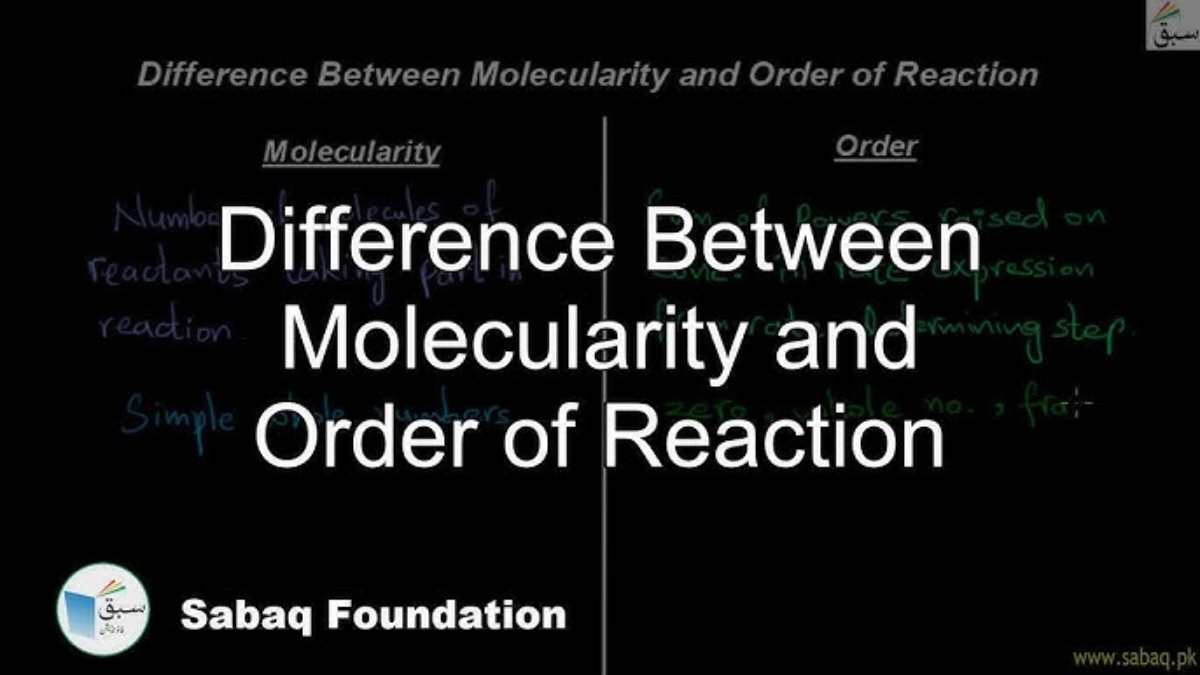
In chemistry, understanding the rate at which reactions occur is crucial for a variety of fields, from industrial chemistry to environmental science. Two important concepts in reaction kinetics, order and molecularity, describe how reactions progress, but they are different in meaning and application. Let’s explore these concepts in detail and highlight the key difference between order and molecularity.
What is the Order of a Reaction?
The order of a reaction refers to the power to which the concentration of reactants raise in the rate law expression for that reaction. Simply put, it tells us how the rate of reaction affect by the concentration of reactants.
For example, consider a chemical reaction:
A+B→CA + B \rightarrow CA+B→C
The rate law for this reaction could be expressed as:
Rate=k[A]m[B]n\text{Rate} = k[A]^m[B]^nRate=k[A]m[B]n
Here, m and n are the orders of the reaction with respect to reactants A and B, respectively. The total order of the reaction is the sum of these individual orders, i.e., m+nm + nm+n.
- If m = 1 and n = 1, the reaction is first order with respect to A and first order with respect to B, making the total order of the reaction 2 (second order overall).
- If m = 2 and n = 0, the reaction is second order with respect to A and zero order with respect to B.
Order is an experimental measure, determined by studying how the reaction rate changes when the concentration of reactants is varied.
Key Characteristics of Reaction Order:
- Experimental determination: The order of a reaction cannot be guessed from the stoichiometry of the reaction but must be determined experimentally.
- Non-integer values: The order of a reaction can be fractional (e.g., 1.5) in some cases, which suggests a complex reaction mechanism.
- Rate dependence: The rate of a reaction changes with the concentration of reactants according to the order. For example, in a second-order reaction, if the concentration of the reactant is doubled, the rate increases by a factor of four.
What is the Molecularity of a Reaction?
On the other hand, molecularity refers to the number of reactant molecules (or particles) that must collide in order for a reaction to occur. It is related to the simplest form of the reaction mechanism and the number of molecules involved in the elementary step of the reaction.
For example, if a reaction proceeds in a single step (an elementary reaction), the molecularity is simply the number of molecules involved:
- Unimolecular reaction: Only one molecule is involved. For example, the decomposition of a molecule A into products:
A→B+CA \rightarrow B + CA→B+C This is a unimolecular reaction, as it involves a single molecule of A. - Bimolecular reaction: Two molecules (either of the same or different reactants) are involved. For example: A+B→CA + B \rightarrow CA+B→C This is a bimolecular reaction because two molecules, A and B, collide to form product C.
- Termolecular reaction: Three molecules collide in a single step. While rare, this type of reaction involves three reactants simultaneously interacting, like: A+B+C→DA + B + C \rightarrow DA+B+C→D
Key Characteristics of Molecularity:
- Defined for elementary reactions: Molecularity is only meaningful for elementary reactions, which are simple, single-step processes.
- Integer values: Molecularity is always a whole number (1, 2, 3, etc.), since it counts the number of particles involved in the reaction.
- Rare for higher values: Reactions involving more than three particles colliding at the same time are extremely rare due to the low probability of such collisions.
Key Differences Between Order and Molecularity
- Definition:
- Order is a concept that applies to the rate law of a reaction and describes how the rate depends on the concentrations of reactants.
- Molecularity is the number of molecules involved in an elementary step of the reaction.
- Applicability:
- Order applies to both elementary and complex reactions and can be determined experimentally.
- Molecularity is only defined for elementary reactions, which proceed in a single step.
- Fractional Values:
- The order of a reaction can be fractional or non-integer (e.g., 1.5).
- Molecularity can never be fractional; it is always a whole number (1, 2, 3, etc.).
- Determination:
- The order is determined experimentally by measuring how changes in concentration affect the reaction rate.
- Molecularity is inferred from the simplest reaction mechanism, typically not determined by experiment.
- Sum of Reactant Concentrations:
- In an order reaction, the total order is the sum of the exponents of the concentration terms in the rate law.
- In molecularity, the number of reactant molecules involved in the elementary step gives the molecularity directly.
Conclusion
Both order and molecularity describe aspects of chemical reactions, but they are distinct in their meaning and how they use. Order is concerned with the overall rate law and how the rate of a reaction depends on the concentration of reactants. Molecularity, on the other hand, focus on the number of molecules involved in the reaction’s elementary steps. While molecularity is an inherent property of the reaction mechanism, the order can vary depending on experimental conditions. Understanding both these concepts is fundamental to studying and controlling chemical reactions.
